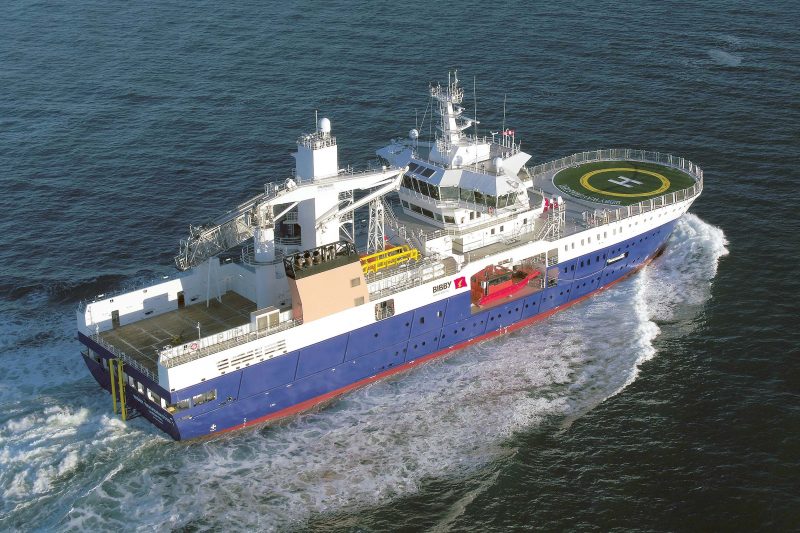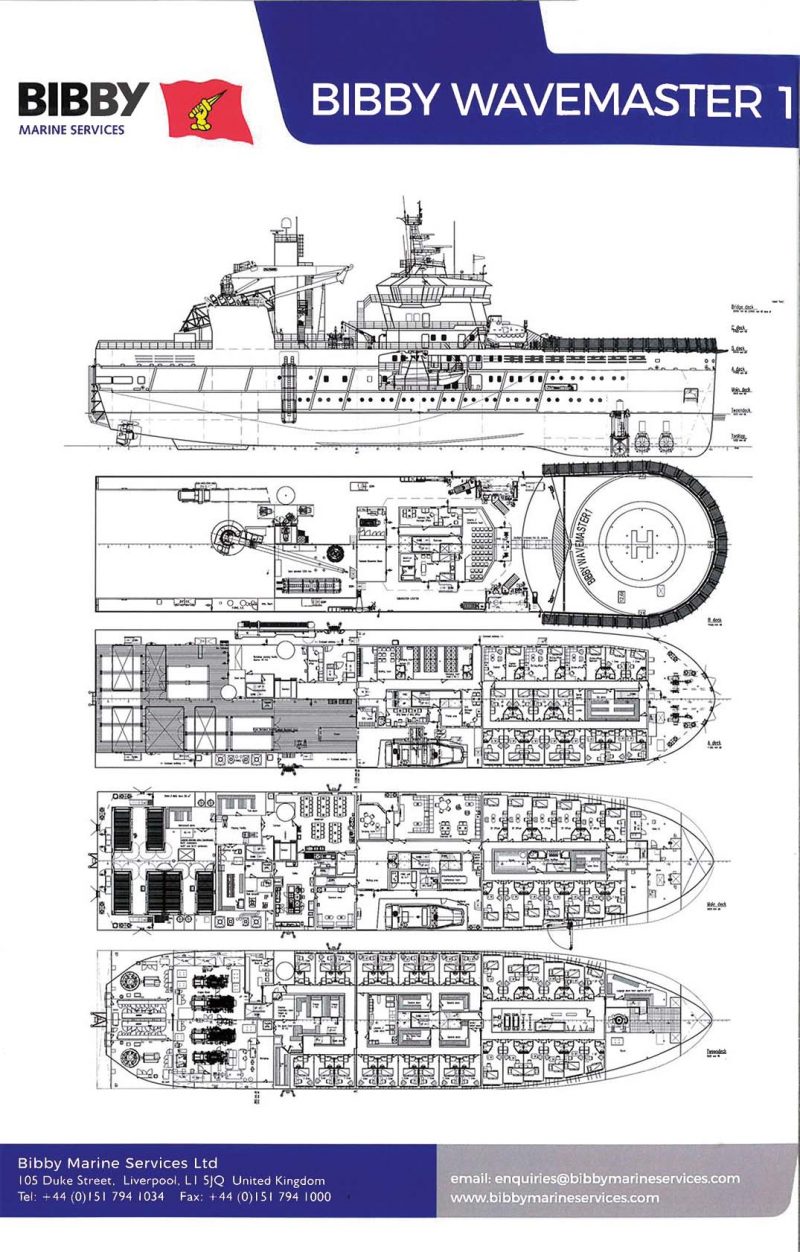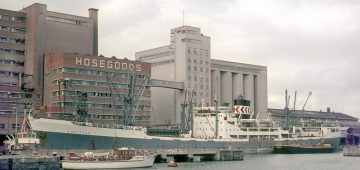The Offshore sector of the shipping industry remains an eclectic one with a large variety of vessels to fulfil all manner of tasks both on the surface and subsea. The growth of the windfarm business has spawned a new generation of construction, accommodation and crew transfer vessels. One of the most risky tasks of any windfarm vessel is the transfer of personnel to and from the turbines and other associated facilities due to sea swell and vessel motion. In 2013 Damen Shipyards unveiled a completely new Wind Farm Service Vessel (WSV) to support and accommodate turbine maintenance crews at sea and allow them to “Walk-to-Work” in preference to stepping/climbing from a moving vessel or a more costly arrival by helicopter. After industry-wide consultation, the vessel was designed from first principles to provide on-site work facilities and accommodation for 45 maintenance personnel plus 15 crewmembers for voyages of up to 30 days in duration. There was a growing trend for wind turbines to be located further from shore so, at distances greater than 30 nautical miles, maintenance crew transfer from shore by sea within one day becomes both impractical and costly. The dynamically positioned (DP2) WSV design included a telescopic, motion-compensated gangway to allow each three-man maintenance team to walk quickly and safely between vessel and turbine in wave heights of up to 3 metres. The 89.65m long, 20.29m beam and 4.6m draught WSV is of a monohull form with bridge and accommodation located amidships. Facilities aboard the ship include a helipad located in the bow, a working deck with an area of 470m² and a motion and heave compensating crane. Such a vessel was designed to deliver seven maintenance crews to sites around a windfarm site within three hours, remaining in range during the hours of work so as to provide support and emergency assistance through the working day prior to pick up. Prior to this design being unveiled, Damen had already carved out a significant presence in the wind farm support vessel market following the launch of its 26m FCS 2610 Twin Axe, a high-speed maintenance support catamaran (also a subject of a previous Newbuild of the Month).
The SOV Concept Blossoms
On 19th September 2014 a contract was signed with Bibby Marine Services Ltd. for the very first example of Damen’s 9020 design adapted to fulfil the WSV role. Bibby Marine Services Limited began trading in 2003 and is a wholly owned subsidiary of Bibby Line Group Limited and serves the marine needs of the offshore renewables market. The newbuild was also the first vessel to be commissioned by Bibby Marine Services Limited. Parent company Bibby Line Group is a diverse family concern and a £1.4 billion business serving its customers for over 200 years. The company operates in more than 20 countries, employing over 4,500 people in industries including retail, offshore, financial services, distribution, shipping, marine based businesses, plant hire and woodland burials. As a precis to the long history, the company can trace its roots back to the early 1800s when John Bibby began trading as a ship owner in Liverpool with his partner John Highfield. By 1836 the Bibby fleet consisted of 18 ships and John had moved the business forward independently of his partner. In 1891 Bibby Steam Ship Co. was established under the management of Bibby Bros. & Co. In 1893 Bibby Line was placed on the approved list for Government officials and their families travelling to Burma and the Far East and the company was operating majestic liners. In 1965 Bibby Line in partnership with Clarksons, Houlder Brothers, Bowstring, Silverline and British Steamship Company established the Seabridge Consortium operating bulk carriers and oil-bulk-ore vessels. Bibby Line started a long association with the LPG sector in 1968 with an order for the gas carrier Wiltshire. This specialist market performed well and she was joined in 1972 and 1974 by the Hampshire and Devonshire. In 1970, Bibby Line was awarded the highest honour that can be bestowed on a UK company, The Queens Award to Industry, and again in 1976 and 1982 with The Queens Award for Export Achievement and in 2001 for Enterprise. With Sir Derek Bibby at the helm the total tonnage of the Bibby Line fleet in the 1970s exceeded one million tons. The Liverpool based company maintains a diverse presence in the maritime industry to this day. At the time of the order being placed the vessel was re-designated as a walk-to-work Service Operations Vessel (SOV). The revision of the vessel description was surely due in part to the fact that Royal Wagenborg had perhaps, in some respects at least, stolen Bibby’s thunder with the WSV concept by introducing the 3,696gt Kroonborg in February 2015 as the first Service Operating Vessel (SOV) for offshore maintenance activities to unmanned platforms and gas production wells. Due to a combination of functions and new techniques the 80m long and Voith Schneider propelled Kroonborg was described as completely unique and was built at the Royal Niestern Sander shipyard in Farmsum, The Netherlands. This SOV offered accommodation facilities for 60 people, including two crews of 20 technicians, and was of course equipped with the ground breaking motion compensated offshore access “Walk to Work” system. Other offshore vessels were also beginning to be built with or retrofitted with this equipment for offshore use. A year after the Kroonborg demonstrated what an SOV could offer, the steel cutting ceremony for Damen’s new baby took place on 1st February 2016 at the Damen Group’s Galati Shipyard (DSGa) on the banks of the River Danube in Romania. The keel laying ceremony for the new breed of SOV 9020 quickly followed on 31st March 2016. The ship’s assigned yard number was 321 553016 and she was constructed in two sections, known as 105 and 106. The yard is the largest of Damen Shipyards Group’s 32 shipyards, repair yards and related companies worldwide. While Damen’s international sales organisation takes care of product development, the self-managed DSGa has developed into a highly efficient production shipyard with a significant output. Since joining the group in 1999, the yard’s shipbuilding expertise and closely-managed supply chain have been behind some of Damen’s most important deliveries to date, fully representing the group’s diverse product portfolio. Damen Galati has a heritage dating back to 1893 and has a highly diversified portfolio including anchor handlers, coastguard vessels, patrol ships/navy vessels, platform supply vessels and logistic support vessels, Ro-Ro ships, ferries, dredgers and barges. Signature Damen vessels like the ASD 2810, ASD 2913, ASD 3212 and Stan Tug 4013 regularly roll off the Galati slipway. Once the two sections of the vessel had been united and further fitting out had taken place, the newbuild, to be named Bibby Wavemaster 1, was launched on 24th March 2017.
Mastering the Market
The 6,241gt Bibby Wavemaster 1 has an unusual appearance in so far as the bulk of her profile consists of the hull structure. As mentioned before, the monohull vessel is based on Damen’s ASV 9020 design and has been adapted to operate with maximum efficiency, while providing a high level of comfort for the crew. The long hull form enables bow thruster integration of which there are three.

In the bow are two 860kW Schottel Gmbh STT004 transverse tunnel thrusters plus a retractable 860kW SRP 550 LSV TT azimuthing thruster. The latter can be deployed to maintain the ship’s position at sea and stowed within the profile of the hull when the ship is underway. The V-shaped bow section reduces slamming and improves the offshore operation of the bow thrusters. The V-shaped frames in the aft of the vessel and a concentration of volume in the centre of the hull also result in a slender aft end, thus ensuring comfortable stern to wave operations. The installed DP-2 dynamic positioning system with radar scan, laser and differential global position reference systems (DGPS) will accurately keep the ship on course or in a fixed position. Three decks are housed within the hull of the Bibby Wavemaster 1. The lowest level is the Tweendeck and around 75% of this from bow to stern consists of 30 cabins to accommodate the majority of the 45 windfarm technicians. The aft section at this level is the machinery space. The diesel-electric propulsion system here integrates two Caterpillar 3516C 690V/60Hz main diesel engines and two 2,150kW electric motors driving two ducted 2150kW Schottel Gmbh SRP 1515 FP azimuth thrusters with fixed pitch propellers. The Caterpillar 3516C marine diesel engine is of a 4-stroke, V16 type. These units have an output of
1650-3386bhp, a speed range of 1200-1800rpm, an 8.46in bore and a 7.48in stroke. The vessel has a service speed of 13 knots and an economy speed of 12 knots at 4.80m draught. The ship has a mission endurance of 30 days. Auxiliary equipment includes four 6,434ekW main generator sets and a 238ekW emergency generator. The configuration of the diesel-electric propulsion with azimuth stern drives and a systematic wind profile improves the fuel efficiency and reduces emissions. One level above is the Main Deck and the forward section contains further cabin accommodation for the technicians. Aft of this can be found offices, recreation and day rooms, hospital, drying and changing rooms, wellness area (gym & sauna) etc. The accommodation areas are deliberately located amidships to minimise vertical acceleration by approximately 15%. Recessed into the starboard side hull at Main Deck is an 11m Tuco Marine Pro Zero Daughter Craft (a windfarm service boat) with an operation limit of 1.2m waveheight. The aft section on this level is a covered warehouse and work area totalling 390m2 (6 x 20ft containers, level floors). The upper most deck within the hull profile is A Deck. The forward section here is again cabin accommodation, for Officers and Crew. All 60 cabins on board are provided with WiFi, LAN, telephone and audio/video entertainment (VOD and satellite TV). The maximum number of people that can be accommodated on the ship is 90 as some of the cabins are double occupancy if necessary. Aft of the cabins on A Deck is a mess room, day/meeting room and office among other facilities. The remaining 50% deck area towards the stern is a working environment and a 425m2 cargo weather deck that can stow eleven 20ft containers. The accepted deckload here is 600t with a vertical centre of gravity (VCG) 1m above the deck. Deck equipment includes an electric-hydraulically operated anchor mooring winch with a rope drum and two warping heads and two electrically operated capstans with a hold force of 5t each plus a tugger winch with a 5t pull, plus wire sheaves, located on weather cargo deck. In the bow on B Deck is a 21m Helicopter Deck capable of a 12t take-off capacity plus day and night landings. There is also step-less access from the warehouse area to helideck via the internal lift. CTV landing facilities are offered in the form of one fixed steel landing at the stern and one removable aluminium landing area on the port and starboard side (stowed on B-Deck when not required). Refuelling equipment is also available at the CTV landing on the starboard side plus helicopter fuel can be carried aboard. The superstructure on B-Deck offers more offices and crew areas for the crew of 15, as does the same area above on C-Deck. The large 360 degree Bridge is atop of C-Deck. The aforementioned lift has a 2 tonne capacity and connects the 6 access levels of the Walk-to-Work tower (which also has an external stairway) for continuous access to the warehouse and weather deck.
On the starboard side aft on B-Deck is a Palfinger knuckle boom deck crane with a safe working load (SWL) of 5t at a 25m outreach and 2t at a 27.5m outreach. The crane is equipped with an active heave compensation (AHC) system to counteract the movement of the ship when in use. The funnel is located outboard of the crane. On the port side of B-Deck, adjacent to the crane, is the 3D motion-compensated Walk to Work hydraulically powered telescopic gangway, supplied by Uptime of Norway, with an adjustable gangway pedestal for height regulation when using the gangway access lift tower. The motion compensation provided enables the equipment to be used in varying sea states of up to 3.1m waveheight. The gangway is the Uptime 23.4 model that has a telescopic reach of 19.4m (plus or minus 4m) from the pedestal centre. The unit can handle the transfer of both personnel and cargo. The telescopic gangway consists of two main components, the aluminium fixed/telescopic part and the steel turret. It is possible to elevate, extend/retract and slew the gangway within certain limits. There is a safe working load of 7 Kilonewtons (approx 0.75t) at gangway tip in motion-compensating mode and a provision for small cargo items to be sent from the warehouse in the stern of the ship to the gangway via the ship’s internal lift and then be taken off the vessel. The gangway manufacturer is a subsidiary of Marine Aluminium AS, an internationally recognised supplier of innovative and sustainable access solutions. Since 1953 Marine Aluminium, based in Avaldsnes, has been designing, manufacturing and supplying aluminium to satisfied offshore, marine and onshore clients.
Launched onto the World Stage
The Bibby Wavemaster 1 was delivered to her owners on 15th August and departed from Galati two days later, arriving in Rotterdam on the 1st September. The naming ceremony took place at Rotterdam’s cruise terminal on 6th September in front of more than 125 guests from the UK-based Bibby Group, Damen and a range of industry partners. More than ten members of the Bibby family attended while the Damen family was represented by Chief Commercial Officer Arnout Damen. The naming, by Lady Sponsor Mrs Jacky Blaikie, was the culmination of a programme that began nearly four years ago to develop a vessel that could meet the needs of the offshore wind industry in an efficient, economic and environmentally-responsible way.
The freshly christened ship then underwent a few days of final systems testing before starting operations on 18th September with James Fisher Marine Services at Innogy’s 336MW Galloper wind farm off the coast of Suffolk, UK, performing three months of winter commissioning work on the project’s substation and 56 Siemens 6MW turbines. Then, on 1st April 2018 the new ship will begin an assignment for Total E&P Nederland, working on gas platforms in the Dutch sector of the North Sea. This 6-month contract (with options to extend up to 3 years) was a conscious decision of Total to examine, explore and utilise techniques developed by the offshore renewables industry and import those techniques into the oil & gas sector. The Bibby WaveMaster 1 will deliver substantial cost savings over the traditional forms of transport/access and accommodation used for gas platform maintenance. Total E&P Nederland will use the vessel in favour of jack up vessels and helicopters and to provide access to gas platforms in the southern North Sea.







Comments
Sorry, comments are closed for this item